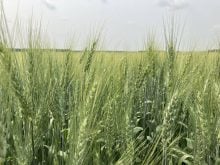Western Canadian farmers could find themselves at war with Hessians this year.Not the 18th century German soldiers hired by the British to fight in the American Revolution, but hessian flies, a pest that can take a bite out of a farmer’s late-seeded wheat crop.The oddly named fly is native to Asia but was transported into Europe and later into North America, supposedly in the straw bedding of Hessian troops.Hessian flies, which are from the same family of insects as the wheat midge, can show up anywhere in the Prairies and are usually associated with late-seeded wheat, said Ian Wise, an entomologist at the Cereal Research Centre in Winnipeg.Damage from the three to five millimetre long black midge-type fly is limited most years.However, conditions could be right for hessian flies in certain areas this year because of the seeding problems experienced by many producers.”We certainly could see more damage this year if there is a significant amount of late-seeded wheat going into the ground,” Wise said.Another problem with the hessian fly is there are no control products available for spring wheat.An Agriculture Canada publication says Disulfoton can be used on winter wheat, but the best methods are crop rotation, early seeding and resistant varieties such as Superb and Waskada. Unfortunately, it’s too late for any of those measures this year.”This year it could be a big problem,” Wise said.Hessian fly larvae feed on the plant at the point where the leaf blade meets the stem. This weakens the stem, predisposing it to breakage and yield loss.It has two generations a year.In winter wheat, fall rain triggers the emergence of flies, which lay eggs and establish the new generation that causes feeding damage to seedlings. A second generation emerges the following spring.The economic impact of hessian flies has not been well documented. Manitoba crop watchers estimate yield loss from broken stems as high as 10 to 20 percent in some years.Wise said researchers periodically have success screening for hessian fly resistance and have looked into the possibility of incorporating resistant genes from winter wheat by backcrossing them directly into spring wheat.Experimental lines have been developed, but Wise said they are a long way from registration.The hessian fly is a much bigger issue in the United States and researchers have been working hard to develop resistant winter wheat varieties.A recent news release from Purdue University in Indiana identified the method by which resistant varieties fight off the fly.A resistant plant under attack will increase production of surface waxes and cutin, a molecule responsibility for the rigidity and integrity of epidermal cells.The genes are turned off in susceptible plants, likely by the attacking larvae.”If we could find a way to block the larvae from affecting genes that are responsible for cutin production or a way to keep that cutin from degrading, the plants might be more resistant,” said entomologist Christie Williams of the U.S. Department of Agriculture and Purdue.
Read Also

Why feds imposed EV tariffs
Moe and Kinew have a fight on their hands when it comes to eliminating the EV tariff. Canada has to worry about pissing off the U.S. and Mexico and hundreds of thousands of auto workers.














